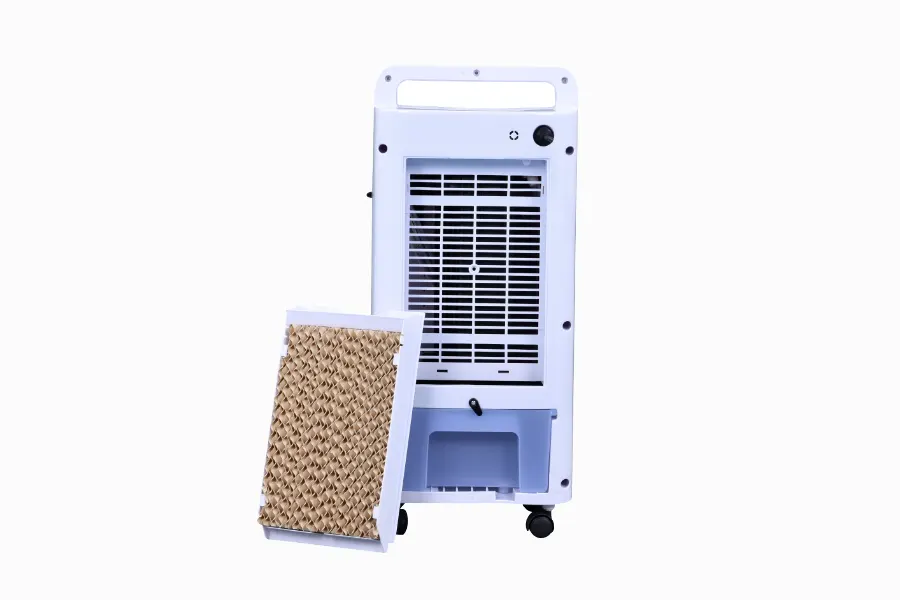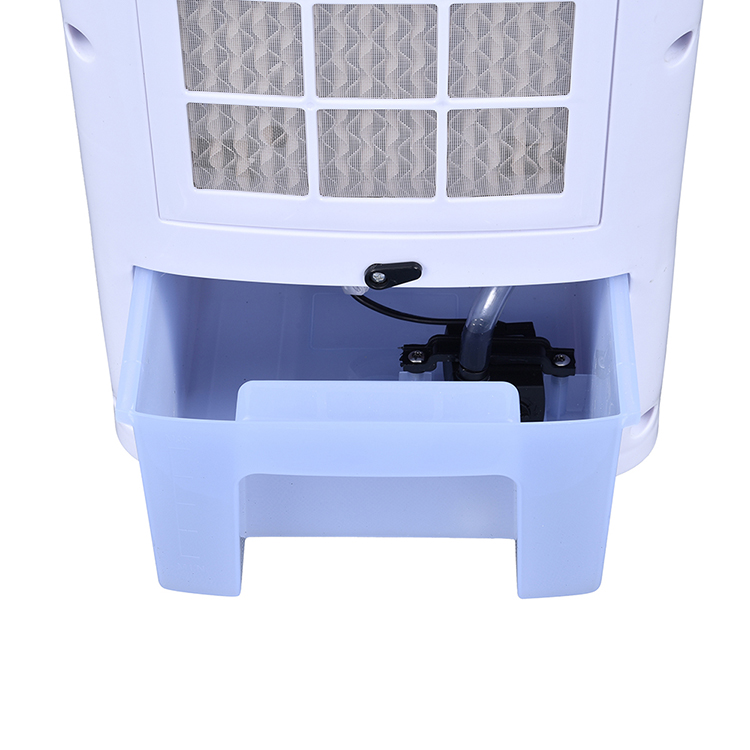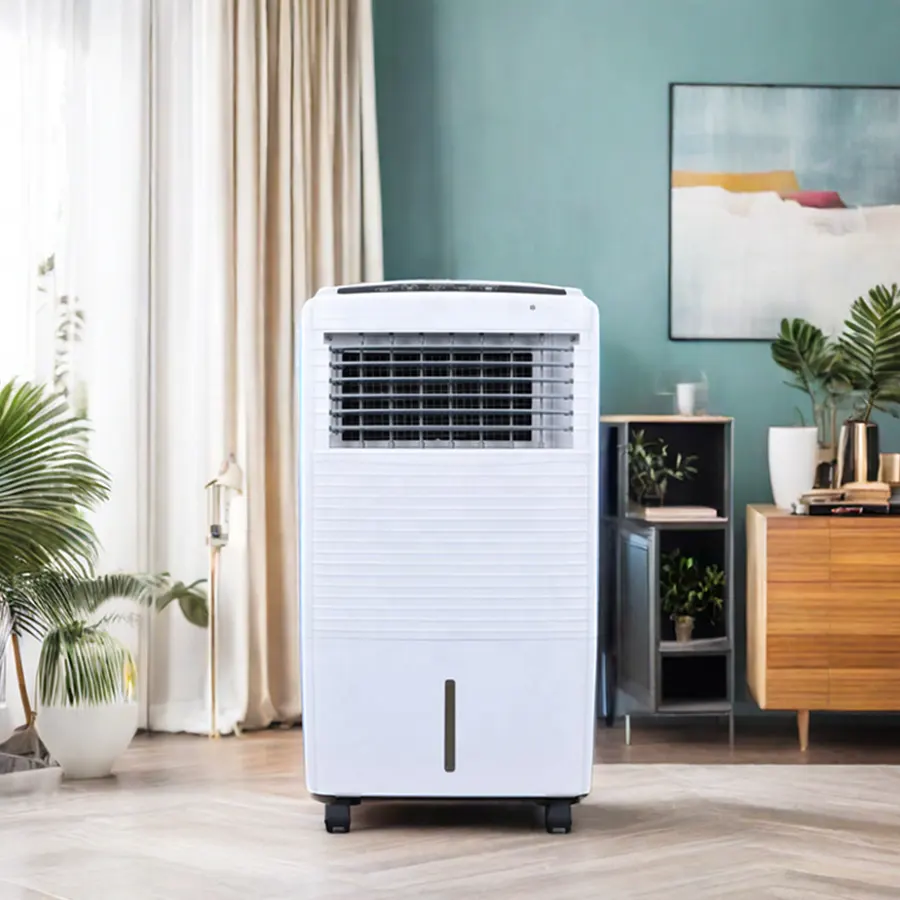Os refrigeradores de ar são essenciais em muitas residências e escritórios, oferecendo uma maneira acessível e com baixo consumo de energia para se refrescar durante os meses quentes. Mas o que acontece nos bastidores do processo de fabricação do refrigerador de ar? Da matéria-prima ao produto final, há muito trabalho necessário para criar essas máquinas de resfriamento. Este guia detalha cada etapa, dando a você uma visão mais detalhada de como os refrigeradores de ar são feitos em uma fábrica.
Introdução à fabricação de refrigeradores de ar

Os refrigeradores de ar não são apenas uma simples mistura de ventilador e água. Há muito mais em seu design, e o processo de fabricação é crucial para determinar o quão bem eles funcionam. Quer seja um refrigerador de ar doméstico ou um refrigerador de ar comercial, cada produto passa por um processo de fabricação detalhado em uma fábrica de refrigeradores de ar. Os componentes devem se encaixar perfeitamente para máxima eficiência, e as medidas de controle de qualidade garantem que apenas os melhores produtos cheguem aos consumidores.
Matérias-primas e componentes para refrigeradores de ar
Principais materiais necessários para fabricação
Cada refrigerador de ar é construído sobre uma base de componentes essenciais, cada um desempenhando um papel fundamental para garantir eficiência e durabilidade. O lista de peças do refrigerador de ar normalmente inclui:
- Quadro: Geralmente feito de aço ou plástico, oferecendo uma estrutura durável e leve.
- Almofadas de resfriamento: Muitas vezes feito de celulose, esses materiais altamente absorventes são essenciais para absorver água e resfriar o ar por meio da evaporação.
- Sistema de motor e ventilador: Um sistema robusto projetado para circular eficientemente o ar resfriado por toda a sala.
- Bomba de água: Garante a circulação contínua de água para manter as almofadas de resfriamento úmidas.
- Sistema Elétrico: Alimenta o motor, fã, e bomba de água, controlando a funcionalidade geral da unidade.
- Tubulação de água: Distribui água do reservatório para as placas de resfriamento.
- Painel de controle: Fornece controle ao usuário sobre configurações como velocidade do ventilador e fluxo de água.
Fornecimento de componentes de qualidade
O sucesso da fabricação de refrigeradores de ar depende fortemente da aquisição de componentes de alta qualidade. O desempenho é diretamente influenciado pelos materiais utilizados em cada peça, e componentes do refrigerador de ar de baixa qualidade podem levar à ineficiência ou até mesmo à falha do produto. Por exemplo, um motor abaixo da média ou placas de resfriamento defeituosas podem prejudicar a eficácia do cooler. Para garantir um produto de alto desempenho, uma fábrica confiável de refrigeradores de ar faz parceria com fornecedores confiáveis para cada componente, atendendo aos padrões da indústria e às expectativas do cliente.
Etapa 1: Design e Prototipagem

Antes de qualquer peça ser feita, a equipe de design trabalha na criação do projeto do refrigerador de ar. É aqui que o olhar, sentir, e fatores de desempenho são decididos. CAD (projeto auxiliado por computador) o software desempenha um grande papel aqui, permitindo que os engenheiros criem projetos detalhados e precisos. Assim que o design estiver pronto, um protótipo é construído para testar o desempenho do refrigerador de ar em condições do mundo real. Se surgirem problemas, ajustes são feitos no design, garantindo que o produto final atenda aos padrões de qualidade.
Etapa 2: Fabricação da Estrutura do Resfriador de Ar
O próximo passo no fabricação de refrigerador de ar processo é construir a estrutura. A estrutura é o que mantém todos os componentes juntos e dá forma ao cooler. Pode ser feito de aço ou plástico durável, dependendo do design do cooler. Uma vez escolhido o material, a moldura está cortada, em forma, e soldado (se necessário) para criar a estrutura básica. Esta etapa é crucial porque a estrutura deve ser robusta o suficiente para suportar o uso diário e ao mesmo tempo leve o suficiente para facilitar o transporte..
Etapa 3: Fabricando as almofadas de resfriamento
As almofadas de resfriamento são o que tornam os refrigeradores de ar únicos. Essas almofadas são projetadas para absorver e reter água enquanto permitem a passagem do ar, resfriando-o no processo. Tipicamente, as almofadas de resfriamento do refrigerador de ar são feitas de material de celulose, que é absorvente e eficiente na transferência de calor. Na fábrica, as almofadas são cortadas no tamanho certo e depois tratadas para melhorar suas propriedades de resfriamento. O teste vem a seguir, pois os fabricantes precisam garantir que cada almofada possa absorver água de forma eficaz e manter o fluxo de ar sem entupir.
Etapa 4: Conjunto de motor e ventilador
A montagem do motor e do ventilador é uma das etapas mais importantes no processo de fabricação do cooler.. O motor aciona o ventilador, que empurra o ar através das almofadas de resfriamento. O motor deve ser forte o suficiente para circular o ar em grandes áreas, mas não tão poderoso que se torne barulhento ou ineficiente. Durante a montagem, o motor e o ventilador são cuidadosamente montados dentro da estrutura, com atenção dada ao alinhamento e fixação dos componentes no lugar.
Etapa 5: Integração de Sistemas Elétricos
O sistema elétrico alimenta o ventilador, bombear, e outros componentes do refrigerador de ar. A fiação deve ser feita com precisão, garantindo que não haja risco de curto-circuito ou falha elétrica. Um painel de controle bem projetado está instalado, frequentemente com configurações de velocidade do ventilador e fluxo de água. Uma vez integrado o sistema elétrico, é hora de testar cada função para garantir que tudo está funcionando como deveria.
Etapa 6: Instalação de Bomba de Água e Sistema de Distribuição

Para que o refrigerador de ar resfrie de forma eficaz, precisa de um fluxo de água consistente para manter as almofadas de resfriamento úmidas. Uma bomba d'água é instalada para circular a água de um reservatório através de um sistema de tubos até as placas de resfriamento. A água deve ser distribuída uniformemente para garantir a máxima eficiência de resfriamento. O desempenho da bomba deve ser testado para garantir que não haja vazamentos e que a água flua suavemente pelo sistema.
Etapa 7: Montagem Final e Gabinete
Com os componentes internos no lugar, é hora de juntar tudo. O motor, fã, almofadas de resfriamento, sistema elétrico, e a bomba de água são cuidadosamente montadas na estrutura. Uma vez montado, o invólucro final ou revestimento externo é adicionado. Normalmente é feito de plástico ou metal durável e é projetado para proteger os componentes internos e, ao mesmo tempo, fornecer um acabamento atraente. A unidade é então selada para evitar que poeira ou umidade entre no maquinário.
Etapa 8: Controle e testes de qualidade
Controle de qualidade é uma parte essencial do processo de fabricação de um refrigerador. Antes de qualquer refrigerador de ar sair da fábrica, passa por testes rigorosos. Engenheiros verificam o desempenho do ventilador, garantindo que ele mova o ar de forma eficaz. Eles também testam a bomba d'água, as almofadas de resfriamento, e o sistema elétrico para garantir que tudo funcione perfeitamente. Os testes de desempenho são realizados sob diferentes condições, e o refrigerador de ar é verificado quanto à segurança e durabilidade.
Etapa 9: Embalagem e Distribuição
Assim que os refrigeradores de ar passarem nos testes, eles são cuidadosamente embalados para distribuição. A embalagem é feita de forma a garantir que o refrigerador esteja protegido durante o transporte, evitando danos à estrutura ou componentes internos. O produto acabado está então pronto para ser enviado aos varejistas ou diretamente aos clientes.
Tendências na fabricação de refrigeradores de ar

Eficiência Energética e Sustentabilidade
À medida que os consumidores se tornam mais ecologicamente conscientes, a demanda por refrigeradores de ar com eficiência energética está crescendo. Os designs modernos de refrigeradores de ar concentram-se na redução do consumo de energia, mantendo o desempenho. Esses coolers geralmente são feitos com materiais recicláveis e apresentam tecnologias de economia de energia que se alinham às tendências globais de sustentabilidade.
Recursos inteligentes em refrigeradores de ar modernos
Muitos novos modelos de refrigeradores de ar vêm equipados com recursos inteligentes, como acesso por controle remoto, Timers, e até sensores que ajustam o resfriamento com base na temperatura ambiente. Estas inovações não só aumentam a conveniência, mas também melhoram a eficiência energética e a experiência do utilizador.
Futuro da fabricação de refrigeradores de ar
O futuro da fabricação de refrigeradores de ar tem tudo a ver com inovação. Os fabricantes estão explorando maneiras de integrar fontes de energia renováveis, como energia solar, em seus designs. Adicionalmente, peças mais frias, como almofadas de resfriamento e ventiladores, estão sendo aprimoradas com novos materiais e tecnologia para aumentar a eficiência e reduzir custos.
Conclusão
O processo de fabricação do refrigerador de ar é uma série de etapas cuidadosamente orquestradas que requer atenção aos detalhes e precisão. Desde a seleção dos materiais certos até o teste final, cada estágio garante que o refrigerador de ar funcione de forma eficaz e eficiente. À medida que as tendências em eficiência energética e recursos inteligentes continuam a moldar a indústria, podemos esperar ainda mais inovação nos próximos anos.
Perguntas frequentes
1. Quais são os principais materiais usados na fabricação de refrigeradores de ar?
Os principais materiais incluem aço ou plástico para a estrutura, celulose para as almofadas de resfriamento, e componentes duráveis para o motor, fã, e sistema elétrico.
2. Quanto tempo leva o processo de fabricação do refrigerador de ar?
Todo o processo pode levar várias semanas, dependendo da complexidade do refrigerador e das capacidades de produção da fábrica.
3. Quais são os principais desafios na fabricação de refrigeradores de ar?
Os desafios incluem o fornecimento de componentes de alta qualidade, garantindo a integração eficiente das peças, e manter um controle de qualidade consistente durante toda a produção.
4. Os refrigeradores de ar são mais eficientes em termos energéticos do que os condicionadores de ar??
Sim, os refrigeradores de ar são geralmente mais eficientes em termos energéticos do que os condicionadores de ar porque usam a evaporação da água para resfriar o ar, em vez de refrigerantes.
5. Quais tendências estão moldando o futuro da fabricação de refrigeradores de ar?
As tendências incluem foco na eficiência energética, recursos inteligentes como controle remoto e sensores de temperatura, e o uso de materiais sustentáveis na produção.





















